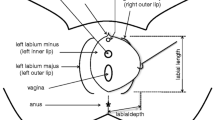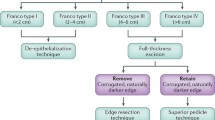Abstract
Introduction and hypothesis
High-quality data are lacking to understand outcomes in women who undergo labiaplasty for labial hypertrophy and whether there is an association with body dismorphic disorder (BDD).
Methods
This was a cross-sectional study of a retrospective cohort of women who underwent labiaplasty for labial hypertrophy at a tertiary care referral center. Women were identified by CPT codes and were included if the procedure was performed by a urogynecologist. The health record was queried for demographic, pre-, intra-, and postoperative data. For the cross-sectional component of the study, participants were contacted to complete a survey.
Results
Thirty-six women met study inclusion criteria; 21 participated in the survey, and retrospective data were available for 20. At the time of labiaplasty, the women had a mean age of 30 ± 12 years and mean BMI of 23.9 ± 4.4 kg/m2. The most common preoperative motivation for undergoing labiaplasty, based on the medical record, was pain (85.0% 17/20). Complications were uncommon and minor. No women met criteria for BDD. Participant survey-reported primary motivation for undergoing partial simple vulvectomy was “pinching” in 10 (47.6%), “pain” in 4 (19.0%), and “appearance” in 7 (33.3%). The majority of women reported that labiaplasty achieved their preoperative goal (20/21, 95.2%).
Conclusions
Women who underwent labiaplasty were primarily motivated by functional concerns, and outcomes indicate a high satisfaction with genital appearance postoperatively as well as a positive effect on body image and quality of life. We recommend that surgeons work to understand what motivates women to pursue surgical intervention by asking about cosmetic concerns.
Similar content being viewed by others
References
Pauls RN, Rogers RG, Rardin CR. Should gynecologists provide cosmetic labiaplasty procedures? Am J Obstet Gynecol. 2014;211(3):218–21.
American College of Obstetrics and Gynecology. ACOG Committee Opinion #795. Elective female genital cosmetic surgery. Obstet Gynecol. 2020;135(1):e26–42.
Crouch NS, Deans R, Michala L, Liao LM, Creighton SM. Clinical characteristics of well women seeking labial reduction surgery: a prospective study. BJOG An Int J Obstet Gynaecol. 2011;118:1507–10.
Dogan O, Yassa M. Major motivators and sociodemographic features of women undergoing Labiaplasty. Aesthetic Surg J. 2019;39(12):NP517–27.
Sorice SC, Li AY, Canales FL, Furnas HJ. Why women request Labiaplasty. Plast Reconstr Surg. 2017;139(4):856–63.
Veale D, Eshkevari E, Ellison N, et al. Psychological characteristics and motivation of women seeking labiaplasty. Psychol Med. 2014;44(3):555–66.
Miklos JR, Moore RD. Labiaplasty of the labia minora: Patients’Indications for pursuing surgery. J Sex Med. 2008;5(6):1492–5.
Trichot C, Thubert T, Faivre E, Fernandez H, Deffieux X. Surgical reduction of hypertrophy of the labia minora. Int J Gynecol Obstet. 2011;115(1):40–3.
Veale D, Naismith I, Eshkevari E, et al. Psychosexual outcome after labiaplasty: a prospective case-comparison study. Int Urogynecol J Pelvic Floor Dysfunct. 2014;25(6):831–9.
Motakef S, Rodriguez-Feliz J, Chung MT, Ingargiola MJ, Wong VW, Patel A. Vaginal labiaplasty: current practices and a simplified classification system for labial protrusion. Plast Reconstr Surg. 2015;135(3):774–88.
Sharp G, Tiggemann M, Mattiske J. Psychological outcomes of Labiaplasty: a prospective study. Plast Reconstr Surg. 2016;138(6):1202–9.
Bucknor A, Chen AD, Egeler S, et al. Labiaplasty: indications and predictors of postoperative sequelae in 451 consecutive cases. Aesthetic Surg J. 2018;38(6):644–53.
Surroca MM, Miranda LS, Ruiz JB. Labiaplasty: a 24-month experience in 58 patients: outcomes and statistical analysis. Ann Plast Surg. 2018;80(4):316–22.
Turini T, Weck Roxo AC, Serra-Guimarães F, et al. The impact of Labiaplasty on sexuality. Plast Reconstr Surg. 2018;141(1):87–92.
Özer M, Mortimore I, Jansma EP, Mullender MG. Labiaplasty: motivation, techniques, and ethics. Nat Rev Urol. 2018;15(3):175–89.
Liao LM, Michala L, Creighton SM. Labial surgery for well women: a review of the literature. BJOG An Int J Obstet Gynaecol. 2010;117(1):20–5.
American Psychiatric Association. Diagnostic and statistical manual of mental disorders. 5th ed. Washington, DC: American Psychiatric Publishing; 2013.
Veale D, Gledhill LJ, Christodoulou P, Hodsoll J. Body dysmorphic disorder in different settings: a systematic review and estimated weighted prevalence. Body Image. 2016;18:168–86.
Zwier S. “What motivates her”: motivations for considering labial reduction surgery as recounted on women’s online communities and surgeons’ websites. Sex Med. 2014;2(1):16–23.
Harris PA, Taylor R, Thielke R, Payne J, Gonzalez N, Conde JG. Research electronic data capture (REDCap)--a metadata-driven methodology and workflow process for providing translational research informatics support. J Biomed Inform. 2009;42(2):377–81.
Bramwell R, Morland C. Genital appearance satisfaction in women: the development of a questionnaire and exploration of correlates. J Reprod Infant Psychol. 2009;27(1):15–27.
Veale D, Ellison N, Werner TG, Dodhia R, Serfaty MA, Clarke A. Development of a cosmetic procedure screening questionnaire (COPS) for body dysmorphic disorder. J Plas Rec Anesth Surg. 2011;65:530–2.
Cash TF, Fleming EC. The impact of body image experiences: development of the body image quality of life inventory. Int J Eat Disord. 2002;31(4):455–60.
Veale D, Eshkevari E, Ellison N, Cardozo L, Robinson D, Kavouni A. Validation of genital appearance satisfaction scale and the cosmetic procedure screening scale for women seeking abiaplasty. J Psychosom Obstet Gynecol. 2013;34(1):46–52.
Garcia B, Scheib S, Hallner B, Thompson N, Schiavo J, Peacock L. Cosmetic gynecology—a systematic review and call for standardized outcome measures. Int Urogynecol J. 2020;31(10):1979–95.
Author information
Authors and Affiliations
Contributions
KP: protocol development, data collection and analysis, manuscript writing.
CAF: protocol development, data collection and analysis, manuscript editing.
This work was be presented at the American Urogynecologic Society Annual Meeting in October 2020.
Corresponding author
Ethics declarations
Conflict of interest
None.
Additional information
Publisher’s note
Springer Nature remains neutral with regard to jurisdictional claims in published maps and institutional affiliations.
Rights and permissions
About this article
Cite this article
Propst, K., Ferrando, C.A. Outcomes of labiaplasty in women with labial hypertrophy. Int Urogynecol J 32, 1247–1251 (2021). https://doi.org/10.1007/s00192-020-04621-w
Received:
Accepted:
Published:
Issue Date:
DOI: https://doi.org/10.1007/s00192-020-04621-w




